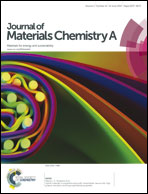Molecular insights into hydrogen bonds in polyurethane/hindered phenol hybrids: evolution and relationship with damping properties
Abstract
In this study, a polyurethane/hindered phenol system was prepared as a melt in order to study the yet unclear mechanism of the formation of hydrogen bonds (H-bonds) in analogous systems. The evolution of intermolecular H-bonds between ester carbonyl/phenolic hydroxyl groups and urethane carbonyl/phenolic hydroxyl groups was detected, for the first time, by infrared analysis. Subsequent dynamic mechanical analysis combined with thermal analysis showed the fluctuation of the glass transition temperatures and the damping properties of the hybrids. From X-ray diffraction analysis the existence was observed of only amorphous hindered phenol in the polyurethane, further molecular dynamic simulation, based on an amorphous cell, characterized the number of H-bonds, the H-bond predominant binding energy and the fractional free volume in a quantitative manner. It was observed that the variation of the simulation data was in accordance with the fluctuation change of the damping properties, thus a relationship was established between the evolution of the H-bonds and the damping properties.


 Please wait while we load your content...
Please wait while we load your content...